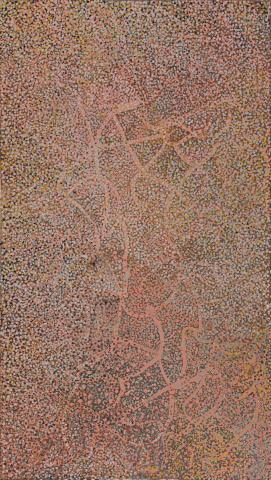UNTITLED, 1990
EMILY KAME KNGWARREYE
synthetic polymer paint on linen
213.0 x 122.0 cm
inscribed verso: artist's name and Delmore Gallery cat. OK05
Delmore Gallery, Alice Springs
Robin Purvis, Eastern Desert Art, Brisbane, 1990
Private collection, Queensland
Emily Kngwarreye, Eastern Desert Art, Brisbane, 6 - 21 October 1990
For two paintings executed at the same time, of the same size and style, see Untitled, 1990, and After the Rain, 1990, held in the collection of the National Gallery of Victoria, illustrated in: Neale M. (ed.), Utopia; The Genius of Emily Kame Kngwarreye, National Museum of Australia and The National Museum of Art, Osaka 2007, pp. 126-127 cat. Nos. D-14 & D-15.
This work is accompanied by a certificate of authenticity from Delmore Gallery which states: 'The most phenomenal fact about Emily is that she is a full ritual Aboriginal of approximately 80 years of age, producing stunningly powerful works of art in a modern abstractionist style, whilst keeping true to her relationship with her country. Each work brings an enthusiastic verbal patter about her place, Alalgura, and the various bush tucker species that rouse her passion.
Emily has spent most of her life at this place, and knows it intimately, in good season - and in bad. It is essentially the power of the red, bare soil, with its countless seeds of energy hidden, lying in wait for rain, that when recognised, binds one forever to the country by the marvels of such a dramatic transformation and the abundance that follows.
Using a broad palette, Emily displays her country in bold and brazen storms of colour, each colour representing the raw, ripe and dry fruit, the bud, the flower, the dry petals, the plant stem, the scattered seeds - all parts of the life cycle.'
Emily Kngwarreye's Untitled, 1990, is one of the significant early paintings that heralded her true beginning as an extraordinary colourist. Emily expanded into a more expressive and experimental palette, which led to the production of works that reflected her brilliant and definitive view of the ripe and raw food sources of her arid country.
In Untitled we renew our perspective and add a dimension to our understanding of Emily's reflective mind whilst in her creative mode. As the viewer, we are drawn into her beautifully worked surface, taking a vertical plunge through the multiple layers of story and meaning.
The narrative of this work relates to the male Emu, shepherding his chicks not long after their hatching, whilst they are dependent on him for their sustenance. This paternal passage is guided by where food can be found for them, and by preferred choice, is often dictated by the spread, or growth pattern, of the yam vine and the nutritious seed of its flower.
JANET HOLT
